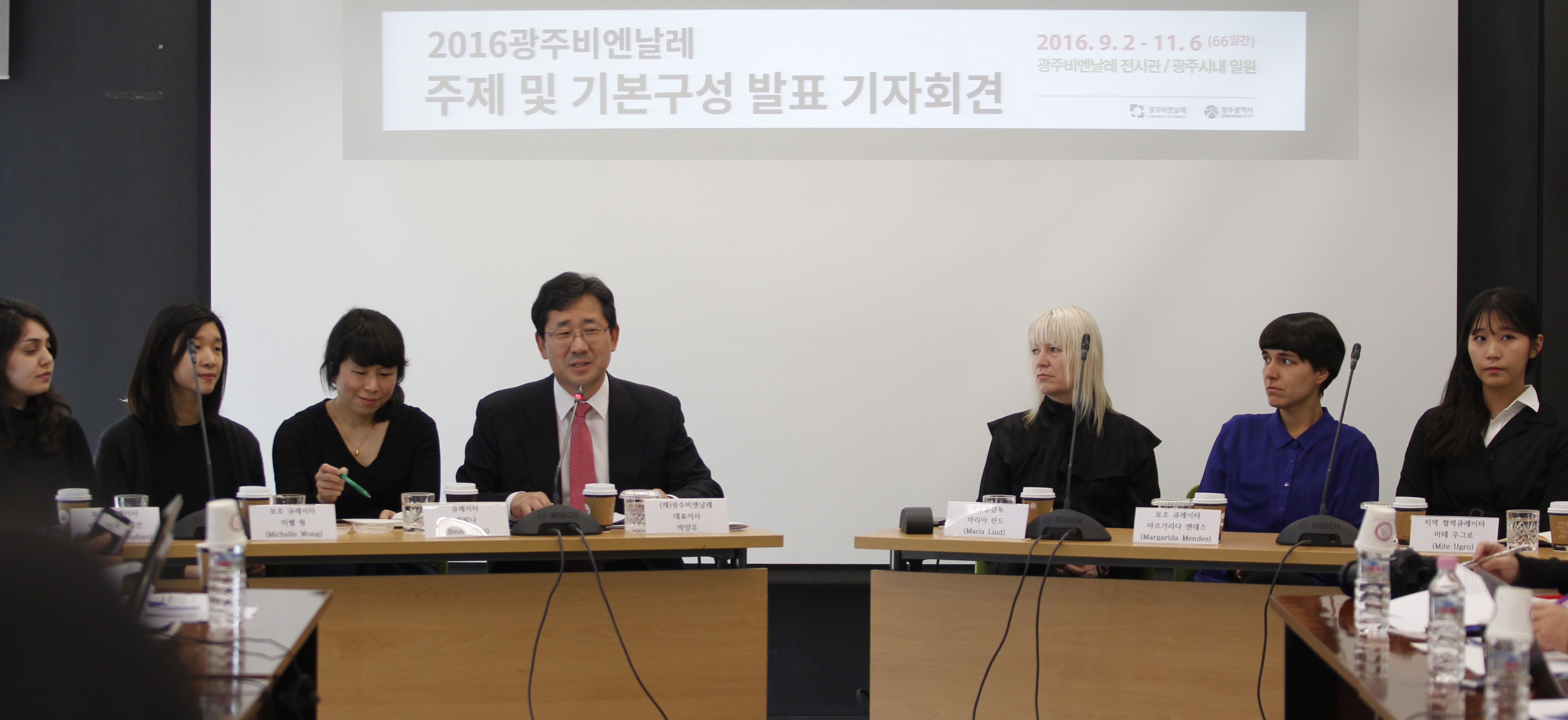Press
Resource Center

THE EIGHTH CLIMATE (WHAT DOES ART DO?)
THE 11TH GWANGJU BIENNALE
2 September –6 November 2016
Press / Professional opening: 31 August - 1 September 2016
Forum: 2-4 September 2016
With Infra-School, Monthly Gatherings, Biennale Fellows, Forum, Exhibition and Publications
Invited artists having already conducted on-site research in March with more to follow subsequently:
Ahmet Ögüt, Amalia Pica, Ane Hjort Guttu, Apolonija Šušterši? with Dari Bae, Bik van der Pol, Bernd Krauss, Céline Condorelli, Claire Barclay, Dora García, Fernando García-Dory, Gunilla Klingberg, Hu Yun, Jewyo Rhii with Jihyun Jung, Joungmin Yi, Julia Sarisetiati, Metahaven, Michael Beutler, Natascha Sadr Haghighian, Siren Eun Young Jung, Søren Andreasen, Tommy Støckel, Tyler Coburn
The curatorial team: Maria Lind, artistic director; Binna Choi, curator; Azar Mahmoudian, Margarida Mendes and Michelle Wong, assistant curators
Local curatorial associate: Mite-Ugro
In light of the art sphere’s focus on infrastructure in many parts of the world, in the treacherous terrains of existing public and private systems, art itself seems to be partly forgotten. At GB11, attention is directed to artworks and projects addressing the agency of art in terms of the question, "what does art do?”. A central part of this interest in the performative aspect of art is its projective and imaginative qualities—art’s active relationship to the future. Other concerns of GB11 include the mediation of art: art’s embeddedness in various contexts and the potential of connecting dots between already existing activities and people near and far.
The “eighth climate” of the exhibition’s title refers to a state one might reach using his or her imaginative capacities. The notion of the eighth climate dates back to 12th-century Persian mystic and philosopher Sohravardi, and was elaborated by 20th-century French philosopher Henri Corbin. It is an addition to the seven physical climates of the earth identified by ancient Greek geographers. Unlike the seven earthly climates, the eighth climate is not based on a separation of matter and spirit, history and myth; rather, it is ontologically real and has concrete effects, but beyond our ordinary perception and understanding. The eighth climate establishes that the knowledge and function of the imagination are real, while escaping rationalism as we know it.
The eighth climate might well resonate with global warming and other factors causing climate change. However, in the context of GB11, the eighth climate helps us explore art’s capacity to say and do something about the future, without either being paralyzed by its prospects or defaulting to established technologies of prediction. The eighth climate evokes art as a seismograph, detecting change before other tools of observation, whether the artists are conscious of it or not, allowing for slightly different—and perhaps ambiguous and conflictual perspectives on how art engages with what lies ahead of us. This neither implies art for art’s sake nor a sheer utilitarian approach.
While placing art center stage, GB11 is a constellation of various parts taking place throughout 2016. Thinking carefully about what art does, GB11 comprises Monthly Gatherings, an ongoing Infra-School, a group of national and international Biennale Fellows, a Forum, two publications and an exhibition which stretches from the Gwangju Biennale building to other venues and places in the city.
Monthly Gatherings is a series of informal gatherings in Gwangju, focusing on art and this city. A collaboration with art collective Mite-Ugro, and with participants such as local artists, students and other Gwangju residents as well as GB11 artists, the gatherings consist of "The Mite-Ugro Art Book Collection,” “Group Readings,” “Artists Screenings,” “The Art Work in Focus”and“Curated Walks.”
With Infra-School, GB11 connects its curatorial and artistic knowledge to the existing formal and informal educational institutions in Gwangju and beyond. Infra-School consists of lectures, presentations, group discussions and seminars by GB11 artists and curators as well as jointly organized conferences, colloquia and fora. Among the Infra-School associates are Chosun University, Hongik University, RAT School of ART, The New Centre, Seoul National University –Asia Centre, and the Inter-Asia School.
The GB11 Biennale Fellows consist of roughly one hundred small- and medium- scale art organizations across the world, whose work makes important contributions to the art world as a whole, yet remains under the radar. Biennale Fellows will continue doing the important work they normally do, without GB11 being involved in their activities. In a two-day forum, Biennale Fellows, as well as their peers and colleagues, are invited to come together, share experiences and discuss the future of this kind of work, especially with regards to questions of value, continuity and scale.